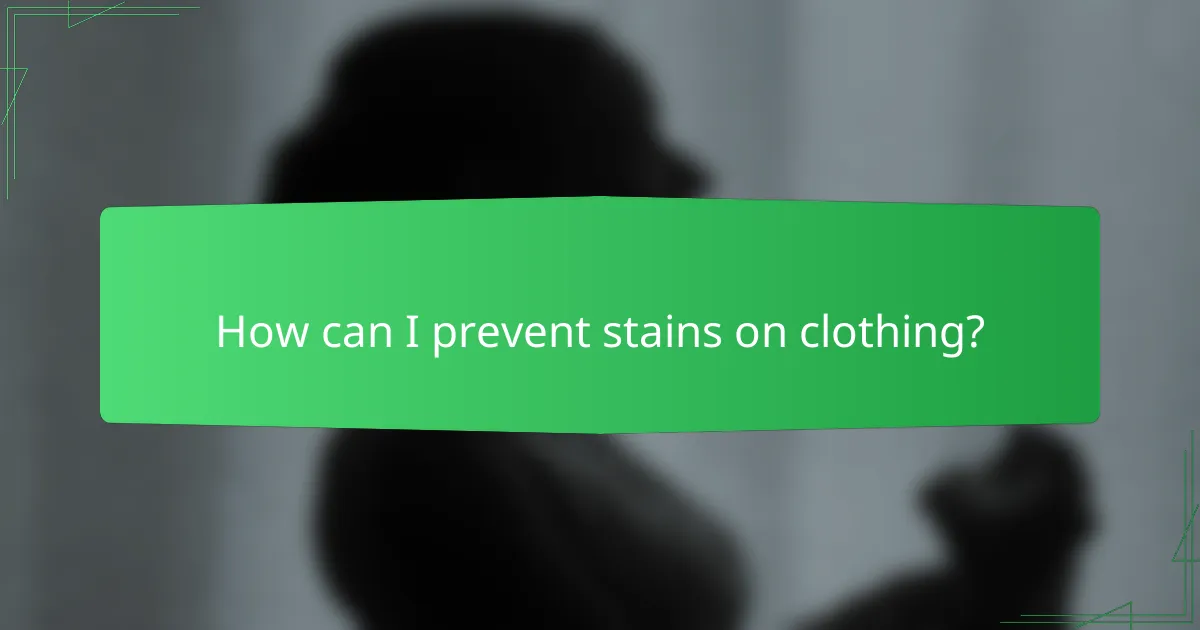Dealing with stains can be a daunting task, but quick action and the right techniques can make all the difference. Understanding how to treat specific stains and considering the fabric type are essential steps in restoring your items to their original condition. With the right approach, you can effectively tackle stains and protect your fabrics from lasting damage.

What are the best quick action tips for stain removal in Canada?
The best quick action tips for stain removal in Canada involve immediate response and the right techniques. Acting quickly can significantly improve the chances of completely removing stains from fabrics.
Blot stains immediately with a clean cloth
As soon as a stain occurs, use a clean cloth to blot the area gently. This helps absorb the liquid without pushing it deeper into the fabric. Always blot from the outside of the stain towards the center to prevent spreading.
Avoid rubbing the stain, as this can damage the fibers and worsen the mark. Use a white cloth or paper towel to avoid transferring any dye onto the fabric.
Use cold water to rinse fresh stains
Rinsing fresh stains with cold water is crucial for effective removal. Cold water helps to lift the stain without setting it, especially for substances like food or drink. Rinse the stained area under running water for several minutes.
For tougher stains, soaking the fabric in cold water for about 30 minutes can be beneficial before further treatment. Avoid hot water, as it can cause certain stains to set permanently.
Apply salt or baking soda for absorbency
Salt and baking soda are excellent absorbent agents for fresh stains. Sprinkle a generous amount over the stain and let it sit for a few minutes to absorb the liquid. Afterward, gently brush off the residue.
These substances work particularly well on stains from red wine or greasy foods. However, ensure to follow up with a proper cleaning method to fully remove any remaining residue.
Test cleaning solutions on inconspicuous areas
Before applying any cleaning solution to a stain, always test it on an inconspicuous area of the fabric. This helps ensure that the solution won’t cause discoloration or damage. Wait for a few minutes to see how the fabric reacts.
Common household cleaners, like vinegar or dish soap, can be effective, but their impact varies by fabric type. If the test area shows no adverse effects, proceed with treating the stain.

How do I remove specific stains effectively?
To effectively remove specific stains, it’s crucial to act quickly and use the right method for each type of stain. Different stains require different treatments, so knowing the best approach can save your fabrics and restore their appearance.
Red wine: Use white wine or club soda
For red wine stains, immediately blot the area with a clean cloth to absorb excess liquid. Then, pour a small amount of white wine or club soda directly onto the stain, which can help neutralize the pigments in the red wine.
After applying the liquid, continue blotting with a cloth until the stain lifts. Rinse with cold water and launder as usual. Avoid rubbing, as this can spread the stain further.
Grease: Apply dish soap and hot water
To tackle grease stains, start by sprinkling baking soda or cornstarch on the stain to absorb the oil. Let it sit for a few minutes before brushing it off. Then, apply a few drops of dish soap mixed with hot water directly onto the stain.
Gently scrub the area with a soft brush or cloth, then rinse with hot water. Repeat if necessary, and always check the fabric care label before using hot water to avoid damage.
Ink: Use rubbing alcohol or hand sanitizer
Ink stains can be stubborn, but rubbing alcohol or hand sanitizer can be effective. Place a paper towel under the stained fabric and apply the alcohol to the stain, allowing it to sit for a few minutes to break down the ink.
Blot the stain with a clean cloth, replacing it as it absorbs the ink. Rinse with cold water and wash the fabric as per its care instructions. Test the alcohol on a hidden area first to ensure it doesn’t damage the fabric.
Blood: Rinse with cold water and hydrogen peroxide
For blood stains, it’s essential to act quickly. Rinse the stained area with cold water to dilute the blood. Avoid hot water, as it can set the stain.
If the stain persists, apply hydrogen peroxide directly to the area. Let it bubble for a few minutes, then blot with a clean cloth. Rinse thoroughly with cold water and launder as usual. Always check fabric compatibility with hydrogen peroxide to prevent discoloration.

What fabric-specific advice should I follow for stain removal?
For effective stain removal, it is crucial to consider the type of fabric you are dealing with, as different materials require specific care. Using the right techniques can prevent damage and enhance the chances of completely removing the stain.
Cotton: Machine wash with bleach for whites
Cotton is a durable fabric that can usually withstand bleach, making it effective for removing tough stains from white items. When washing, use a mixture of detergent and bleach, following the manufacturer’s instructions for dilution. Always check the care label to ensure bleach is safe for the specific cotton item.
For colored cotton fabrics, avoid bleach and instead use a color-safe stain remover. Pre-treat the stain by applying the remover directly and letting it sit for a few minutes before washing.
Wool: Use cold water and mild detergent
Wool is sensitive to heat and harsh chemicals, so it is best to use cold water and a mild detergent for stain removal. Gently blot the stain with a damp cloth rather than rubbing, which can cause the fibers to felt. Rinse thoroughly to remove any soap residue.
For tougher stains, consider using a wool-specific stain remover. Always test any product on a hidden area first to ensure it does not damage the fabric.
Silk: Hand wash with gentle soap
Silk is delicate and requires careful handling to avoid damage. Hand washing is the preferred method; use cool water and a gentle soap specifically designed for silk. Soak the stained area briefly, then gently agitate the fabric without scrubbing.
After washing, avoid wringing out the silk. Instead, lay it flat on a clean towel to absorb excess water, then air dry away from direct sunlight to prevent fading.
Denim: Use vinegar for color retention
Denim is generally robust but can fade with harsh treatments. For stain removal, mix equal parts of white vinegar and water, and apply it to the stain. Let it sit for a few minutes before rinsing with cold water.
To maintain color, wash denim inside out and avoid high heat when drying. If the stain persists, repeat the vinegar treatment or consider a specialized denim cleaner.

What are the prerequisites for effective stain removal?
Effective stain removal requires prompt action, knowledge of the stain type, and an understanding of the fabric involved. These factors significantly influence the success of cleaning efforts and help prevent permanent damage.
Identify the type of stain
Determining the type of stain is crucial for selecting the right removal method. Common stains include oil-based, protein-based (like blood or dairy), and tannin-based (such as coffee or wine). Each type requires a different approach for effective removal.
For instance, oil stains often need a degreaser, while protein stains may respond better to cold water and enzymatic cleaners. Knowing the stain type helps in choosing the most effective treatment.
Know the fabric care instructions
Understanding the fabric care instructions is essential to avoid damaging the material during stain removal. Check the care label for specific washing guidelines, temperature settings, and recommended cleaning agents. Fabrics like silk or wool may require gentler treatment compared to cotton or polyester.
For example, while cotton can typically withstand hot water, delicate fabrics may need cold water and mild detergents. Always follow the care instructions to maintain the integrity of the fabric.
Gather necessary cleaning supplies
Having the right cleaning supplies on hand can make stain removal more efficient. Common supplies include blotting paper, clean cloths, stain removers, and specific detergents suited for the fabric type. A basic stain removal kit can be helpful.
- Blotting paper or clean cloths for absorbing excess liquid
- Stain removers tailored to specific stain types
- Fabric-safe detergents
- Cold and warm water for rinsing
Before starting, ensure you have these items ready to avoid delays and increase the chances of successful stain removal.

How can I prevent stains on clothing?
Preventing stains on clothing involves proactive measures that minimize the risk of spills and marks. Simple strategies can significantly reduce the chances of staining your garments.
Use stain repellent sprays
Applying stain repellent sprays can create a protective barrier on your clothing, making it easier to wipe away spills before they set. Look for sprays specifically designed for fabrics, as they can repel liquids and prevent stains from adhering.
When using these sprays, follow the manufacturer’s instructions for application and drying time. Regular reapplication may be necessary, especially after washing your clothes.
Avoid eating over clothes
Eating over your clothes increases the likelihood of food spills and stains. To minimize this risk, try to eat at a table rather than while standing or walking, and be mindful of your movements while handling food.
If you must eat in a less controlled environment, consider using napkins or plates to catch any potential spills. This simple habit can save you from frequent laundry mishaps.
Wear aprons during cooking
Wearing an apron while cooking is an effective way to protect your clothing from grease, sauces, and other potential stains. Choose an apron made from a durable, washable fabric that can withstand spills.
Make it a habit to put on an apron before you start cooking, especially when preparing messy dishes. This small step can greatly reduce the need for stain removal later on.
